I may get commissions for purchases made through links in this post.
There are many things to love about the RV lifestyle. The endless miles of rolling roads; the sense of open space; the knowledge that you’re really getting to see the soul of a place rather than sticking to the downtown tourist hotspots.
Fulltime RV’ers know that making things work in cramped living conditions has its charm. The big issue however, is that standard-issue RV mattress or your old worn out, caved in coil spring mattress can be incredibly uncomfortable.
If you’ve slept on one you’ll know it’s hard to appreciate the sights when you’re stiff and grouchy from a bad night’s sleep
Why the manufacturer’s interests don’t match yours
The truth is that manufacturers choose the furniture in an RV for weight, not comfort. A light mattress means fractionally more miles to the gallon for your vehicle; it also means bumps every time you roll over in bed and a sore back in the morning.
These thin mattresses may be fine if you only spend a night or two at a time on your RV, but if you plan on sleeping in it for more than a few days, have health problems, or plan on living in your rig, you may need to switch the manufacturer’s own-brand mattress for one of your own choosing.
Here’s how RV mattresses are different
Sometimes, RV mattresses are a pain in the neck, in both senses of the word. Well, that’s perhaps a bit too much, there are some things to keep in mind though.
- They are usually 6 inches shorter than standard mattresses (to fit the smaller bed frames on motorhomes) so can only be bought from specialist manufacturers.
- Some RVs have curved bed frames or snipped-off corners, to allow access to cupboards or bathrooms; this means mattresses must be shaped to fit the frame. The unusual dimensions mean that RV mattresses are usually more expensive than standard ones, and require more effort to buy.
- Prices vary greatly. A top-of-the-range mattress can cost as much as a small car but there are very affordable and well-reviewed, highly comfortable mattresses available too. In fact, you can get a really good one for approximately $200 for a double.
How to get the best start
If you’re planning to buy a brand new RV, the easiest thing to do is to make sure the manufacturer includes a good mattress as part of the deal.
Betsy Dresser has RV’d full-time for the last 4 years and blogs about her travels at RV-A-Gogo. She recommends getting the best possible mattress when you buy your RV new:
“We had 2 choices at the time, and we chose our Tempurpedic mattress because the other was what they called a ‘standard’ mattress – whatever that meant!”
The ‘standard’ OEM mattress is usually a cheap, flat strip of foam; if you have the option to upgrade when you buy a new vehicle, take it.
If you’re not in the market to replace your whole RV, though, there are a few tips which can help you to get the best replacement for your current mattress.
What mattress do I need?
The first question to ask yourself is: do I need a new mattress at all?
If your mattress is too thin, rock-hard, or has springs poking you, but otherwise in good condition, then try using a mattress topper.
A 3 inch mattress topper made of memory foam may be enough to make a hard bed comfortable, and it’s much cheaper than replacing the whole mattress.
A 4,75″ foam topper for our RV bed transformed our nights from waking up aching to pure shuteye bliss. It’s like lying on a cloud.
If your mattress is sagging, lumpy, or too soft, then a topper won’t help the problem, and you’ll have to bite the bullet and get a new mattress.
Evanne Schmarder, RV travel and cooking expert from RV Cooking Show, has been a full-time RV’er for 15 years. She says there’s no point trying to save money on a mattress:
“A mattress is an investment, get a good one and you’ll be assured a good night’s sleep. You can always take it with you if you sell your rig.”
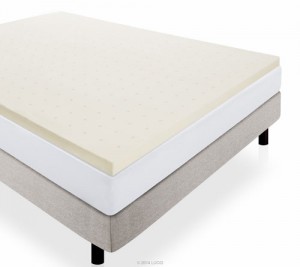 Your choice of mattress will be dictated by the size and shape of your vehicle, as well as personal comfort. If you use a pull-out sofa bed, for example, your mattress will need to be flexible enough to fold into the frame. Also keep in mind that a full length mattress may interfere with closing the slide.
Your choice of mattress will be dictated by the size and shape of your vehicle, as well as personal comfort. If you use a pull-out sofa bed, for example, your mattress will need to be flexible enough to fold into the frame. Also keep in mind that a full length mattress may interfere with closing the slide.
If you have drawers and handles above the bed, then a too-thick mattress may block them off.
Consider how often the bed is used – the more time you spend in your RV, the more money you should spend on your mattress. A mattress which is fine for short trips may become a health hazard with long-term use.
A popular choice is the Lucid Ventilated Memory Foam Mattress Topper (short queen).
Measuring for your new mattress
Measure the inside of the bed, not the mattress. Old mattresses can shrink and warp with time, so you might end up with inaccurate measurements.
The standard RV mattress sizes are as follows:
- RV Twin (single): 34” wide x 75” long
- RV Full/RV Double: 49” x 75”
- RV King/Short King: 72” x 75”
- RV Queen/Short Queen: 60” x 75”
Mattress depth can vary from 3 inches to about 9 inches, depending on the style.
Tip: always check sizes religiously. Terms like “double” and “single” don’t have any specific legal definition – a manufacturer could sell you a dog bed and call it queen size.
The exact sizes vary between manufacturers, so check the measurements of a mattress and not just its name. For example, some manufacturers make RV mattresses which are 74” long, not 75”.
Imagine the frustration of getting your mattress unpacked, only to discover it is half an inch too wide for the space.
Types of mattresses
Most standard RV mattresses are made from some type of foam, because it is light and easy to package. These vary from low-priced plastic foam to sophisticated natural latex. You can also get sprung mattresses and inflatable air mattresses sized to fit RVs.
Scott Oster works for the specialist retailer Park Lane Mattresses, and recommends matching the type of mattress you use at home:
“Your body is used to sleeping on a specific mattress type, so a drastic change from your home to RV is a recipe for poor sleep and an uncomfortable trip.”
Of course, this may not be possible for everyone – if your budget is tight, you will have to take your pick from the mattress options available.
Pros and cons of foam mattresses
These are the basic mattresses which most manufacturers put into their RVs – prices start from about $150 for a single. Most are made from a thick layer of dense urethane foam, with a thinner layer of soft foam on top for comfort.
They are usually petroleum based, but some more expensive ones are topped with eco-friendly soy or natural latex foam – many RV’ers prefer latex foam, as it has a naturally cooling effect.
Mattress foam needs to be tough to deal with fluctuations in temperature. The higher the density of the foam, the more durable it is: 1.5 to 2lbs per cubic foot is the usual range, and 1.8lbs per cubic foot is usually the minimum recommended for comfort.
Bear in mind, though, that higher density foam doesn’t ‘breathe’ well, so firm mattresses can feel a bit sticky on warm nights. However, many come with toppers that quickly solve this issue.
Lesser quality foam mattresses eventually get squashed flat and start to sag in the middle, so they are best suited to RVs which are only used occasionally (no more than 3 months a year).
High quality high density foam mattresses are used fulltime and are known to comfort even those with back problems.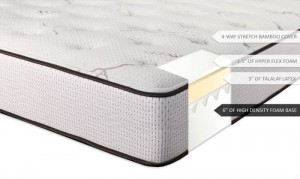
A popular high quality mattress that fits most RV’s is the Dreamfoam Bedding Ultimate Dreams mattress.
Pros and cons of memory foam mattresses
Memory foam mattresses are the usual mid-range choice for RVs, starting at about $400. They have the same urethane base as a cheaper mattress, but they are topped with memory foam which molds to your shape.
This reduces tossing and turning (great if your partner is a wriggler), and can reduce back pain. As with other types of foam, the density tells you the quality – 2.5-5lbs per cubic foot is usual for memory foam.
Arizona native Mello Mike uses a compact truck camper, so he knows all about comfort in restricted spaces. He prefers memory foam:
“It’s more comfortable and insulates better. Ditch your old spring mattress and buy a memory foam. The difference in comfort is quite stark and worth the extra cost”
- Memory foam has a reputation for feeling sweaty, but this is less of an issue with new foam types – if you’re buying a mattress second-hand, make sure it is made with the new breathable open-celled foam rather than the old closed-cell type.
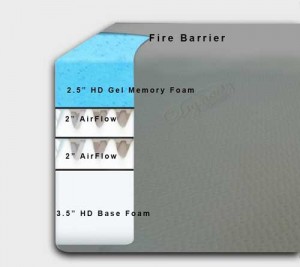
- Some mattresses are made with gel memory foam, which is designed to feel cool to the touch. All types of memory foam can feel stiff and uncomfortable when you first get in, because it is the heat of your body which helps it to soften, but this can be easily fixed with an electric blanket or hot water bottle.
The Dynasty Coolbreeze Memory Foam RV Mattress is cheap, very supportive and comfortable (especially in hot weather) and ventilates well. Keep in mind that you will have to give this mattress a few days to lose its new smell.
Pros and cons of air mattresses
An RV air mattress is similar to a standard blow-up guest bed, but with a soft foam top layer to make it comfortable for everyday use. They are a pricey choice – from about $1000 – but a good air mattress is incredibly comfortable.
Some air mattresses (such as the Sleep Number brand) have two sides which can be individually adjusted to different levels of firmness, which is fantastic if you and your spouse have different sleeping habits.
They are also fairly easy to move and store, making them ideal for beds which aren’t often used (e.g. extra bunks).
Mello Mike mirrors many RV users’ feelings when he says,
“I don’t trust air mattresses. They can be punctured and deflate.”
- Though they are comfortable, all air mattresses have a risk of leakage, and require careful maintenance. A rapid change in altitude (for example, driving up a mountain) can make a firmly-inflated air mattress burst.
- If you’re traveling through hilly areas, you’ll have to get into the habit of adjusting the pressure regularly, to avoid an expensive bang.
- If your air mattress develops a hole, or the membrane is weakened by age and starts to let air out, it will gradually deflate every night as you sleep. The air bladder itself is wrapped in a layer of foam padding, which means it is usually impossible to get in and do a DIY repair without ripping the mattress to pieces.
- You’ll have to send it off to a specialist to be fixed – and frankly, there’s usually not much price difference between repairing an old mattress and buying a new one.
Pros and cons of spring or coil mattresses
These are mattresses like the type most people have on their bed at home – spring and coil mattresses are just two different names for the same thing. They are definitely more comfortable than a foam mattress, but they are not always suited to the average RV. A thick sprung mattress is very heavy, and a thin one tends to lose its bounce pretty quickly.
- Also, they have a tendency to collect condensation when the temperature fluctuates, so unless you have a slatted bottom to your bed (to allow air to circulate), they can develop a nasty build-up of black mold on the underside.
- Still, if your RV is suitable, a good sprung mattress can make you feel like you’re living in a hotel on wheels, rather than sleeping on a bus. Sprung mattresses are durable (as long as your bed is sufficiently well ventilated) because they can be flipped over to keep them fresh – foam mattresses are usually only soft on one side so cannot be turned.
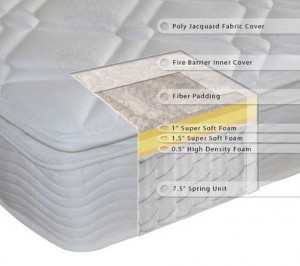
- A lot of sprung RV mattresses come with a pillow top, which is a layer of foam cushioning stitched to the top of the mattress. An 8-in thick pillow top mattress will be slightly lighter than a normal flat-top sprung mattress of the same thickness, but it will also wear out faster.
- The coils underneath will last for years, but the thin layer of foam will quickly become flattened and lumpy, rendering the whole mattress uncomfortable. Better to get a flat-top mattress, and add a foam topper which can be replaced when it runs out.
Ikea carries some cheap sprung mattresses in odd sizes which may fit your vehicle; if you have no luck with that, you’ll probably have to commission one made to measure, as most RV mattress sellers specialize in foam or air mattresses.
A commonly recommended spring RV mattress is the Sleep Master 10″ Pillow Top Spring RV Mattress. Reviewers state it “sleeps like my $3000 Tempur-pedic”
Commissioning a mattress
If you can’t find quite the right mattress for sale, you can order one made for you. This can be the best option if you have an oddly-shaped bed or your bed is not a standard RV size.
For various RV brands such as American, Airstream, Baja, Coachmen, Fleetwood, Sunnybrook, Allegro Bay, Edge, Jayco, Northwood, Skyline, Thor, and Winnebago you may need a custom mattress.
- Cut-corner mattresses are quite common in RVs, so you can occasionally find good deals on these online (from about $400 for a double) – but if your bed has curved corners, sloped sides, or a trapezoid shape, you’ll be unlikely to find anything ready-made to fit your requirements.
- If you decide to commission a mattress, the manufacturer will give you detailed instructions on how to measure the bed, or send you a template to trace around. Commissioned mattresses are non-refundable, so make sure to follow the company’s instructions exactly to get the correct size.
Scott Oster at Park Lane Mattresses points out that the mattress industry is the oldest cottage industry left in America, and the craftsmen who make the mattresses have decades of experience:
“A mattress that goes through craftsmen’s hands will be of higher quality than one made by automated machines and assembly lines. It is comparable to a fine meal prepared by a well-trained chef versus a frozen dinner made on an assembly line”
Most of the cost of a hand-made mattress is in the specialist labor, so if you’re commissioning a mattress you might as well go for the most luxurious finish you can get.
Prices usually start from about $700 for a single, and you’ll have to wait at least a week for the mattress to be built from scratch. The quality is unbeatable, but it’s a major investment.
Personalizing a mattress
The best way to get a mattress to fit a weirdly-shaped bed is to order one made to measure. If you can’t afford that, or you balk at spending $1200 on a mattress you’ll only use three weeks a year, then there is a cheaper option: DIY it
It is possible to cut bits off a standard foam mattress to make it fit your bed. You will definitely void the warranty on the mattress by doing this, but many people would rather risk ruining a $300 mattress than pay for a customized one.
An electric carving knife (the type you use to cut turkey) is the best tool for cutting through thick foam – scissors or a knife will leave jagged edges.
There are several websites which sell different types of foam cut to measure. Thrifty RV users have found that you can buy a block of dense polyurethane foam cheaply online, trim it to shape if necessary, and then attach a soft foam topper.
This gives an effect similar to a purpose-built foam mattress. Although this won’t be quite as durable as a professionally-made mattress, it’s fine for a bed which is only used occasionally.
Buying your RV mattress
If you have the chance to visit an RV mattress showroom, take it. Advice is helpful but it only goes so far: the only way to be really sure that a mattress is right for you is to test it.
Lie on it for at least 15 minutes, on your back and on your side, noting any pressure points or discomfort. RV mattress showrooms are few and far between: if you’re driving close to one and you have a few hours free, it may be worth stopping to test out a few different options even if you aren’t planning to buy a new mattress immediately.
Your next best option is a specialist RV mattress retailer. Some online retailers only sell mattresses, others manufacture them from scratch. Although you won’t be able to test out the mattress before buying, the staff should be happy to talk to you on the phone about your options and advise you.
Scott Oster says that good mattress companies are easy to contact and should be happy to help you:
“Phone, email, and physical addresses should all be easily available. Can you actually talk to a live person at the company, or is it simply automated responses?”
He recommends checking where the mattresses are actually manufactured – many RV companies are US-based but quietly import their mattresses from Mexico or China.
(Of course, mattresses from Mexico and China aren’t necessarily worse quality than ones made in American factories. They are, however, much cheaper to manufacture. If your mattress company imports from abroad, make sure they are passing the cost savings on to you.)
- Make sure to know upfront what the total price will be. Quotes by sellers may not include shipping and handling costs which can add up to the total costs.
Tip: don’t purchase right away when at a dealer but take your time to think about it. This gives you the chance to find a bargain online too.
Buying your RV mattress online
A lot of RV’ers buy their mattress online. If you do, make sure to check reviews really well so you’ll know what to expect. Testing a mattress in a showroom can give you an idea but you’ll never know for sure until you have slept on it for a few nights in a row.
There are also plenty of online retailers, for example, Amazon, Camping World and Overstock all carry a range of well-reviewed RV mattresses.
These may not be specialists but you can find fantastic deals on these websites. Although these sellers are dealers rather than experts, you can learn a lot by reading reviews.
- Let’s say reviewers claimed the mattress was not too firm and not too soft either but when you got it installed in your rig you find it too firm for your taste you can always add a pillow top to soften it up.
- Reading reviews will also tell you about scents, comfort and review updates will inform you about durability.
These websites are brilliant for bargain-hunting if you already know exactly what you want. The customer reviews can give you valuable insight on quality and user experiences.
Second hand RV mattress buying
The final option is to buy a mattress second-hand. Sites like eBay, Oodle, and Craigslist often carry advertisements for RV mattresses, though you may have to wait for months until something suitable comes up.
There is also the option of posting requests on specialist RV message boards. You will have to pick up the mattress yourself (as the mattress will be too big to send by mail), so you’ll be limited to sellers in your local area. Second-hand mattresses start from about $50 and, like all second-hand goods, they vary considerably in quality.
Collecting and unpacking your mattress
RV mattresses are usually delivered vacuum packed and rolled into a tight bundle. They expand into their original size once the packaging is opened.
The tight ‘sausage’ shape makes them easier to maneuver into the bedroom, but make sure you get it into position before cutting the plastic.
Sometimes there’s a slight chemical smell to a new mattress (from the flame retardants it is sprayed with in the factory) but this will dissipate in a few days.
- Tip: Soy foam has no ‘new foam odor’ which can be good to know if you’re sensitive to chemical odors or suffer from migraines.
If you have allergies or breathing problems, though, it may be worth arranging to sleep somewhere else for a couple of nights until the fumes have evaporated (outgassing).
Before buying your new RV mattress, consider something which people often forget until too late: how are you going to get the old one out?
Manufacturers usually put the mattress into the RV when it is only half completed, lowering it by crane through the hole where the roof will be.
This means that it may well be too big to fit through the door. Getting the old mattress out may require removing all the other furniture, unscrewing the door frame, or inviting all your friends over for a mattress-moving party.
What you should know about returns and exchanges
When buying an RV mattress online, check the returns and exchanges policy very carefully. Most sellers offer a 30 day money-back guarantee, but 95% of the time, this is worse than useless.
Why?
It’s all to do with the size of the items. RV mattresses are sent vacuum-packed because delivery companies will only handle packages below a certain size.
Once the mattress has re-inflated, you’ll never be able to jam it back into the box it came in. A fully-sized mattress like this is too large for a delivery person to handle, so if you want to send it back to the manufacturer, you will have to pay to send it as freight.
Sending large freight item across the country will cost several hundred dollars. Even if you get a refund on your mattress, you’ll never recover your postage costs. You might as well give the mattress to a homeless shelter and save yourself the effort.
Some companies will send a pack-it-yourself home vacuum bag on request, or will refund your money if you show evidence that you have donated the mattress to charity.
- Tip: If you’re planning to buy a mattress online, ask for detailed information about their returns policy before you pay.
Making your mattress last
Buying a new RV mattress requires some diligence. Comparing a various different models, measuring your rig, dropping a (few) weeks’ wages on your final choice, and finally installing your new mattress (and getting the old one out).
But it’s totally worth it, good sleep is essential. It makes you thrive and enjoy your trips more. And once you’re set you’re good to go for years.
Here are some tips to let it last even longer.
Now take good care of your new mattress, so you don’t have to do that again for another decade. Evanne Schmarder of the RV Kitchen recommends:
“Treat your RV mattress just like your stick-home mattress. Vacuum regularly, wash the covers and pads, and rotate the mattress for even wear.”
Regularly rotating or flipping the mattress helps to keep it soft and springy for longer.
A comfortable night’s sleep can make the difference between a good and a great holiday. Whether you’re a full-timer or a two-weeks-a-year RV’er, it’s worth investing in the best mattress you can afford.






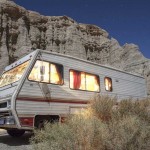
















Very informative post. Thanks for sharing those tips for making the mattress lasts much longer . I recently shortlisted some mattresses from surplus furniture http://www.surplusfurniture.com/ as all my other mattresses have worn out pretty fast. Though I would prefer using organic mattresses, they are much safer and eliminates a lot of chemical related illness.
Being in the futon business, I cater a lot to the RV buyer when it comes to quality RV mattresses. Otis Bed produces the best quality foam mattresses. These mattresses are light weight, extremely dense, very durable and provide superior comfort. They have a lifespan of 10 plus years with frequent usage. Special sizes are available upon request and shipping in the United States is free.
http://www.urbanfutonbeds.com/Best-Futon-RV-Mattresses-s/158.htm
Hello,
You really cleared up a lot of things for me. It’s really hard to find proper info about mattresses that isn’t just some commercially sponsored blurb. I’ve been looking for a good mattress. I’ll be shifting to Tulsa around New Year’s and I’m throwing out the old Spring mattress cause i think it’s lived its life. Is there a affordable brand you recommend? I’m really set on Memory Foam mattresses, but the ones with the cooling gel things get a bit expensive. I have mild spondylitis and so a good mattress is really crucial. If you have a recommendation for pillows, I’d be willing to listen to that as well.
Thank you
Janna Jamieson
When I originally left a comment I appear to have
clicked the -Notify me when new comments are added- checkbox and now each time a comment is added I get four emails with the same comment.
Is there a way you are able to remove me from that service?
Thanks a lot!
Thanks for the great read.
Very attractive! And excellent work on this blog! Love it!